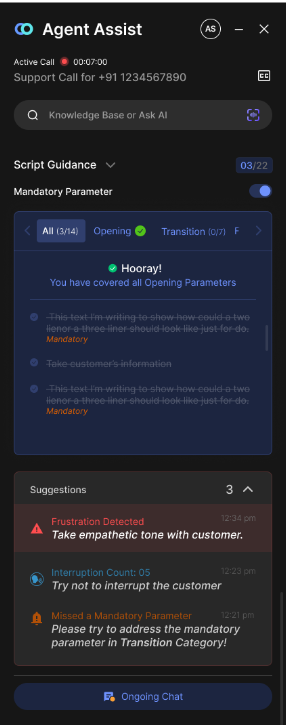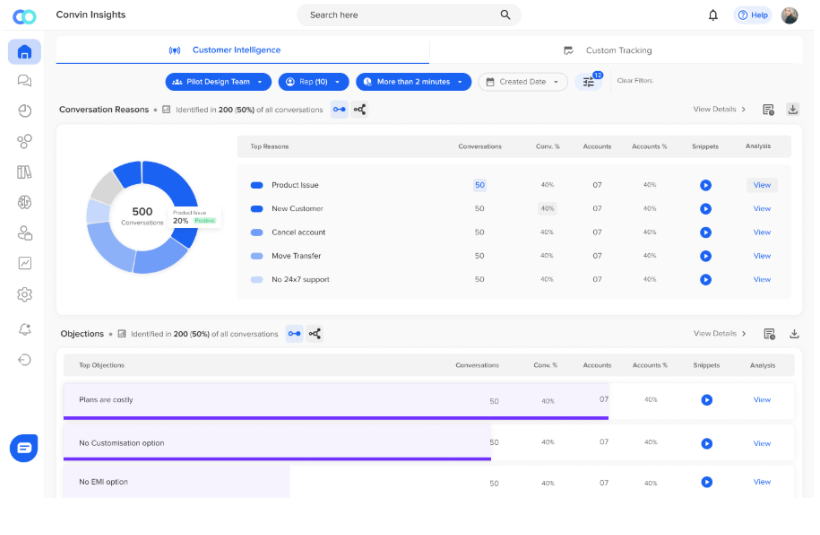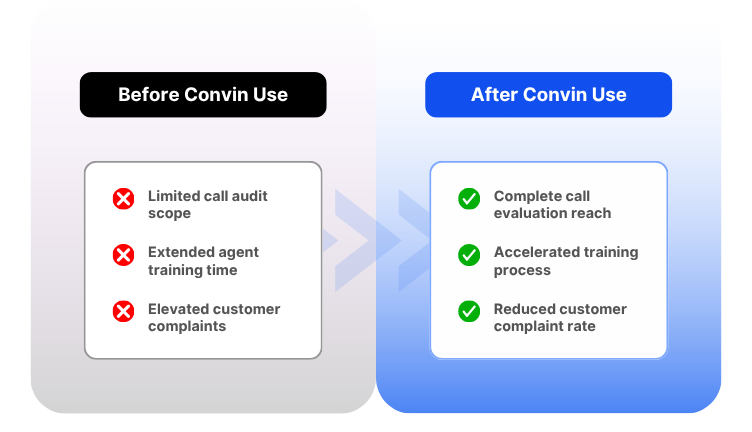Enterprise insurance teams are being asked harder questions, about budget allocation, revenue contribution, and what each line item delivers back to the business. Technology spending, especially in AI, is under close inspection.
The priority isn’t innovation for its own sake, it’s premium growth, improved margins, and provable outcomes.
This blog breaks down what enterprise insurers need to make that case. You’ll get a clear, operational view of how AI in insurance supports a revenue-driven model, mapping agent activity to conversions, calls to wins, and conversations to premium uplift.
It also details how platforms like Convin help insurers meet both sales and finance goals by consolidating performance insights, automation, and revenue analytics into a single framework.
Whether you're presenting a business case or validating results, this is a field guide to proving the impact of AI in insurance where it matters most.
See how Convin helps insurers turn AI-powered calls into revenue
Why AI in Insurance Must Prove Its Economic Value
Enterprise insurers face overwhelming pressure to turn technology investments into measurable returns. According to the ACORD 2025 Insurance Digital Maturity Study, only about 25 % of major carriers have truly digitalised their value chain, yet full digital maturity could reduce P&C insurers’ expenses by up to 14.6 %. (Source)
In the context of AI in insurance, this means any upgrade must clearly link agent and call activity through to conversions and premium uplift.
1. Digitalization in Insurance: Pressure to Quantify Outcomes
Digitalization in insurance now demands more than upgraded systems or customer portals. As enterprise teams push for growth under constrained budgets, every tech decision must contribute directly to revenue or efficiency gains.
Yet, most digital initiatives stall when they can’t tie back to business outcomes such as premium uplift or reduced acquisition costs. With AI in insurance, you gain the data granularity to track every stage of the sales funnel.
Instead of measuring activity in isolation, digitalization in insurance should reveal how calls, meetings, and agent behavior influence revenue. The shift is from improving operations to enhancing enterprise value. This transformation must be backed by a TEI-focused approach that connects metrics with margin.
Digitalization in insurance only earns its place on the budget sheet when it drives measurable revenue through AI in insurance and full-funnel intelligence.
2. AI Agents in Insurance: Link Activity to Revenue
AI agents in insurance are actively supporting high-volume call operations in large insurers. These systems guide agents in real time, helping shape customer interactions and influencing key conversion points.
Moreover, AI agents allow teams to track every action’s financial impact. How many connects turned into meetings? How many meetings were converted? What was the policy value? These aren’t soft metrics.
Convin reports that intelligent automation in insurance enabled cost reductions of 20‑30% in core workflows such as claims, underwriting, and service.
This insight directly supports the insurance sales ROI model, allowing teams to replace assumptions with real-world data. Finance teams don’t have to “believe” in the tech; they can measure its effect on deal velocity and policy revenue.
AI agents in insurance drive real-time performance improvements and enable revenue mapping that finance leaders demand.
To move the conversation from potential to proof, insurers need hard numbers, metrics that show where AI in insurance drives real financial outcomes.
Activate Convin’s AI agents to boost conversions across your sales funnel
Total Economic Impact of AI in Insurance for Enterprises
Enterprise insurers are accelerating AI adoption, but clear impact trails behind deployment. A recent industry stat reports that 76% of life and annuity carriers now implement generative AI in some capacity. However, scaling AI in insurance requires translating these deployments into measurable value.
1. Total Economic Impact Insurance: Metrics that Matter
When building a case for AI in insurance, it’s critical to frame the total economic impact insurance generates, not just operational gains. Convin’s platform helps insurers understand where revenue is being created or lost across thousands of daily interactions.
Key TEI metrics include:
- Increased connect-to-meeting ratios
- Higher policy close rates
- Average premium uplift per agent
- Lower cost per acquisition (CPA)
- Reduced agent training and QA costs
- Enhanced policy persistency
One Convin use case demonstrated how 100% call audit coverage reduced quality issues and led to higher agent performance across geographies.
AI in insurance enables leaders to tie core activities to business results, elevating total economic impact insurance from theory to verifiable outcome.
2. Insurance Sales ROI Model for Budget Decision-Makers
Enterprise buyers require more than anecdotes, they need a robust insurance sales ROI model. With Convin, leaders build ROI projections based on real usage data: calls per rep, connect rate, conversion rate, and average premium.
AI in insurance feeds into this model by influencing each input. Real-time prompts increase meeting rates. Conversation analysis boosts close rates. Voice of Customer tools help retain and upsell. These improvements turn into revenue and margin uplift, precisely what Finance needs to see.
Rather than presenting generic benefits, the insurance sales ROI model must highlight TEI metrics like increased policy value per win, or 30% faster ramp-up for agents due to reduced training reliance with Convin.
The insurance sales ROI model gives buyers the confidence that AI in insurance delivers financial impact, not just operational efficiencies.
Once the economic impact is understood, the next step is knowing which tools actually deliver it. That’s where Convin comes in.
Quantify Convin’s AI impact on revenue with a clear, finance-ready model
This blog is just the start.
Unlock the power of Convin’s AI with a live demo.

Convin’s TEI Engine: Connecting Conversations to Premium Uplift
Every insurance conversation has potential, either to move the sale forward or to stall it. The way enterprise insurers leverage AI in insurance can determine how much of that potential is realized.
Tools like real-time agent assist, conversation analytics, and VoC insights turn customer interactions into data-driven decision points. The upcoming sections highlight how Convin integrates these capabilities into a unified system built for premium uplift.

1. Real-Time Agent Assist: Increase Deal Velocity
In high-stakes sales environments, speed and accuracy win. Convin’s Real-Time Agent Assist gives insurers a tool that improves conversion rates by surfacing dynamic prompts, objection-handling scripts, and compliance guidance, right during the call.
This feature of AI in insurance not only accelerates deals but also supports a stronger insurance sales ROI model. When agents close faster, handle more calls, and reduce training time, the economics improve.
For example, enterprise insurers have reported faster time-to-first-policy and increased quota attainment with Convin’s AI agent support.
Real-Time Agent Assist translates directly into TEI by driving more meetings, faster closes, and increased premium throughput.

2. Conversation Intelligence: Operationalize What Works
Most sales teams don’t know why top performers win. Convin’s Conversation Intelligence records every customer call and extracts patterns that matter, win-trigger phrases, objection drop-offs, sentiment issues, and competitor mentions.
This layer of AI in insurance workflow enables enablement, pipeline forecasting, and playbook design. Rather than gut-feel coaching, sales leaders use actual data to improve conversion rates and tighten the insurance sales ROI model.
These insights also feed back into the total economic impact insurance generates over time. Conversation Intelligence makes your sales process repeatable, measurable, and ROI-positive by turning calls into data-backed strategies.
3. Voice of Customer: Turn Feedback into Forecasts
Voice of Customer (VoC) analytics is often siloed or reactive. Convin’s VoC tool, part of its AI suite for insurers, proactively surfaces insights from thousands of calls: recurring objections, unmet needs, and product confusion.
These insights are vital to refining underwriting, sales offers, and service scripts. For large insurers, integrating VoC into the insurance sales ROI model allows leaders to identify revenue opportunities before they emerge in CRM metrics.
VoC also strengthens the total economic impact insurance produces, through improved retention, cross-sell success, and higher customer lifetime value.
Voice of Customer turns raw call data into action plans that grow premium revenue and increase enterprise-wide ROI.
With evidence in hand, the path forward is clear. It’s time to look at what AI in insurance should mean for your strategy.
Book a demo to unlock revenue signals hidden in your sales calls.

Enterprise Insurers Achieving TEI with Convin
Enterprise insurers are shifting from pilots to measurable impact, especially when they adopt the right tools. With Convin’s platform, one organisation increased its call‑audit coverage from just 2% of interactions to 100%, and cut customer escalations by 50% within a year. (source)
In the same deployment, lead‑time for agent onboarding was reduced by 48%, enabling faster ramp‑up in negotiation and close activities.
For Senior Sales and Finance leaders eyeing ROI, this means you can map connects → meetings → wins with concrete data.
Rather than experience lagging behind intention, you get visibility across the funnel, faster time‑to‑policy and control over premium outcomes.
1. Before vs After: cost and revenue clarity
A major insurer switching to the Convin platform expanded audit coverage from just 2% to 100% of customer conversations, while reducing agent onboarding time by 48% and cutting customer‑escalation volumes by 50%. (Source)
These figures offer CFOs and sales leaders a clear route to map improved operational controls and agent productivity into tangible cost reduction and revenue lift.
Gaining full visibility across interactions enables insurers to translate previously hidden costs into visible margin improvement.
2. Enterprise case: full‑funnel visibility to close
In a case study of enterprise deployment, Convin’s funnel logic linked agent calls to meetings booked, to policies closed, illustrating how measurement and tracking enable full‑funnel clarity.
This level of visibility supports stronger budget justification, especially when linked to premium growth and shorter sales cycles. Full‑funnel traceability turns AI in insurance from a pilot to a strategic revenue lever, closing the loop between spend and premium.
Explore how Convin helps map every call to premium outcomes with data
Next Steps for Revenue-Focused Insurers
AI in insurance is now expected to deliver outcomes, not just automation. For revenue-focused insurers, that means full-funnel visibility, tracking how every call, conversation, and agent action contributes to policy wins and premium growth.
From real-time guidance to post-call analytics and voice of customer insights, the key is connecting daily execution with measurable impact.
Convin brings these capabilities into one platform designed to support enterprise decision-making and sales acceleration.
Its solutions don’t just enhance performance; they quantify it, tying agent behaviors to results finance teams care about. If you're looking to link conversations with revenue, the data and the path are now clear.
Book your Convin AI demo today!
FAQ
1. How is AI used in insurance companies?
AI in insurance companies is used to streamline operations and improve decision-making across claims processing, underwriting, fraud detection, customer support, and sales. Tools like real-time agent assist and voice analytics help insurers personalize interactions and close more policies efficiently. Platforms like Convin enhance agent performance during live calls and uncover conversion patterns from every interaction.
2. How has AI helped restore faith in insurance companies?
AI has improved response times, reduced claim errors, and ensured consistent communication, key areas where customer trust often erodes. By analyzing voice-of-customer data and automating routine processes, insurers using AI deliver faster, more reliable service. With conversation intelligence from tools like Convin, insurers gain insights that allow them to act proactively, reducing friction and increasing satisfaction.
3. How many insurance companies are using AI?
As of 2025, over 70% of large insurers globally have adopted some form of AI in their operations, with many expanding use to claims, sales, and underwriting. In life and annuity segments alone, 76% of carriers report active AI implementation. Adoption continues to rise as more insurers integrate AI to improve both customer outcomes and internal efficiency.
4. What are some tasks that traditional AI is commonly used for in the insurance sector?
Traditional AI in insurance is commonly used for:
- Claims triaging and fraud detection
- Customer service via virtual agents
- Policy recommendations
- Underwriting risk assessments
- Real-time call analysis and compliance alerts
Convin’s platform, for example, uses AI to assist agents live, analyze 100% of customer calls, and identify performance gaps that directly impact conversions.









.avif)